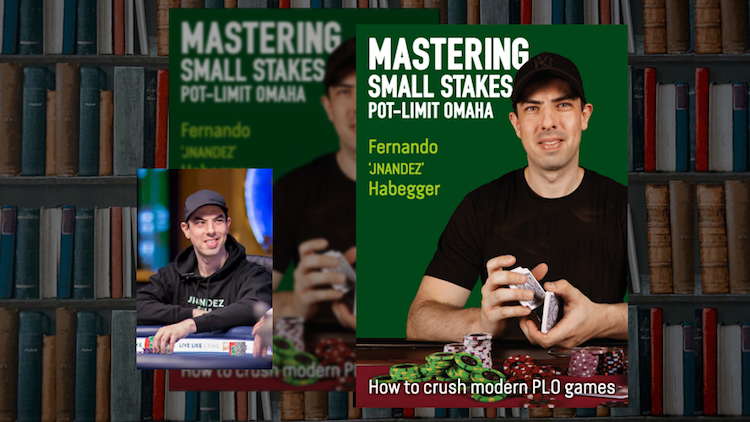Pot-limit Omaha players have a new resource to help them when playing those double-suited wraps, when betting and raising pot, and when attempting to realize their equity in one of poker’s most exciting variants.
Hot off the presses, Fernando “JNandez” Habegger‘s new book Mastering Small Stakes Pot-Limit Omaha shows how players can improve their PLO skills in order to gain an edge.
Habegger draws on a decade’s worth of experience as a player and coach to share all the tools needed to enjoy a big advantage, especially in smaller stakes PLO games.
In Mastering Small Stakes Pot-Limit Omaha, Habegger helps readers understand common mistakes and learn to avoid them. He also shows how players can start exploiting those same mistakes in others.
With a clear, easy-to-follow style and lots of helpful hand examples, Habegger comprehensively covers both PLO cash game and tournament strategy. The book additionally provides advice about other areas including mentally dealing with PLO’s big swings and bankroll management for PLO.
The following excerpt comes from the section of the book dealing with preflop strategy. Specifically, Habegger here is introducing a discussion of three-betting before the flop, focusing from the start on the importance of three-betting and the reasons for doing so.
Preflop Ranges
3-Betting Fundamentals
Introduction
3-betting is a big part of PLO, especially given how many players rarely fold after getting 3-bet. These big pots can have a massive influence on your win rate, so let’s ensure that you have the right fundamentals and the proper 3-betting preflop ranges.
To Call or to 3-Bet
Keep in mind that when you decide to 3-bet, you are giving up on cold-calling, and vice-versa. You must understand the benefits of both options since they are mutually exclusive.
When you 3-bet, you will often play a heads-up pot since the other players at the table now have to make a much bigger preflop investment to enter the pot. In 3-bet pots, the SPR [Stack-to-Pot Ratio] is much lower than in single-raised pots. In 3-bet pots at 100bb, the SPR will be around 4, which means that you will very often be playing for stacks.
When you are cold-calling an open-raise, it’s more likely that you will end up in a multiway pot, especially if you are cold-calling from one of the early positions. In live games or small stakes online games, many pots will go multiway because you are likely facing a lot of players with very wide preflop ranges who don’t adjust correctly for multiway play. Single-raised pots at 100bb will usually play at an SPR of around 13 which means that you need a much stronger hand to stack off on the flop, especially when you are playing multiway.
Positional Advantage
Another key difference is that when the SPR is low, as in 3-bet pots, the out of position player has less of a positional disadvantage given that they can more easily go all-in on the flop or turn. That means that they can often avoid playing the river out of position. The river is a tricky street to play in PLO, given how often the nuts change and how that impacts the out of position player.
In high SPR situations, the out of position player has to play all three streets with this situational drawback. This robs them of EV which is, in turn, gained by the IP player. So, having a high SPR increases the IP player’s positional advantage, as they can leverage it through multiple streets.
Reasons to 3-Bet
Please note that this explanation is a simplified version to introduce you to why and when you should consider 3-betting preflop. In further chapters, we will analyze this concept in more detail.
We have already indicated that a 3-bet pot leads to a low SPR scenario, where players are likely to stack off on the flop or turn. Your opponents know that they can stack off with a piece of the flop and something to go with it. If they hit a pair and a draw, or a combo draw, they are happy to go all-in. Therefore, your goal in 3-bet pots is to dominate your opponent in such stack-off scenarios.
The best hands to accomplish that goal are pair plus draw type hands that dominate your opponents’ similar holdings. Ideally, you want to flop top pair and a high flush or straight draw versus middle pair and weak flush or straight draw. You need to accomplish this postflop goal by constructing your 3-betting range with this precise purpose in mind.
Therefore, there are two main reasons to 3-bet:
3-bet to Push an Equity Edge
You should 3-bet hands that want to build a big pot with an equity advantage. The main type of 3-betting value hands are A-A-x-x, A-K-K-x, and A-Q-Q-x. An additional type are double-suited high cards, which are hands that are double-suited, have very good connectivity and Broadway or near-Broadway cards or pairs. Altogether, these amount to only about 3.5% of all hands.
3-bet for Better Playability
The second reason to 3-bet is for playability. Hands that want to 3-bet for playability often have a very smooth equity distribution, meaning that they flop good equity on a large number of flops. These hands are also non-nutted, so they are not optimized for multiway pots. This means that 3-betting becomes more appealing to make the pot heads-up. This category includes a lot of non-nutty high double-suited rundowns. They still need to mostly feature high ranking cards because you are hoping to dominate your opponent’s postflop stack-off range. Even though they lack nuttiness, their equity versus the range of just one player is quite high and they add a lot of playability to your range going into a low SPR postflop scenario.
Mastering Small Stakes Pot-Limit Omaha by Fernando “JNandez” Habegger is now available in paperback or as an e-book at D&B Poker.
D&B Publishing (using the imprint D&B Poker) was created by Dan Addelman and Byron Jacobs 15 years ago. Since then it has become one of the leading publishers of poker books with titles by Phil Hellmuth, Jonathan Little, Mike Sexton, Chris Moorman, Lance Bradley, Martin Harris and more, all of which are available at D&B Poker.
Back to Top







